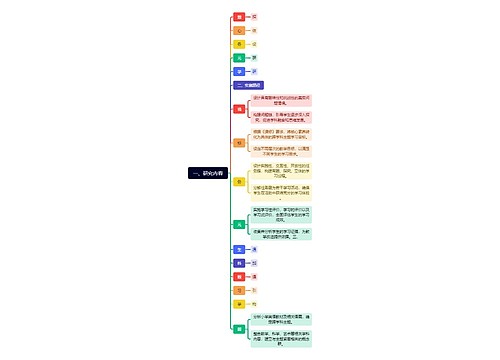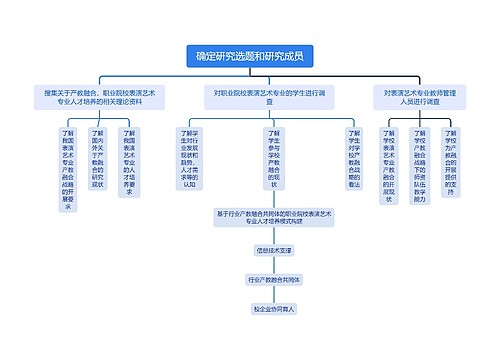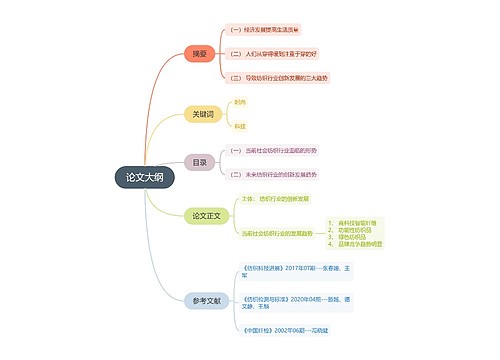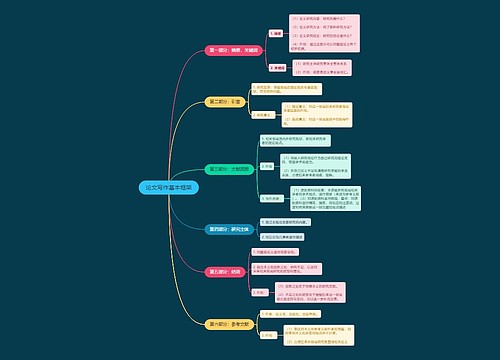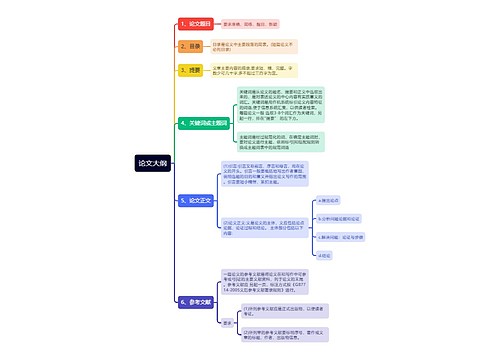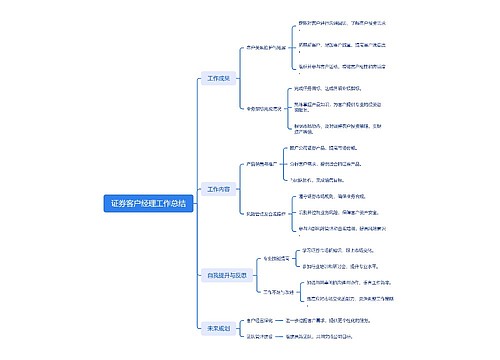
1 Basic Information About Research Paper Writing思维导图
U268103138
2024-05-31

孤立词的频率和可靠性
科研论文写作的基本信息
哲学思辨的论文
科研论文写作的基本信息介绍
树图思维导图提供《1 Basic Information About Research Paper Writing》在线思维导图免费制作,点击“编辑”按钮,可对《1 Basic Information About Research Paper Writing》进行在线思维导图编辑,本思维导图属于思维导图模板主题,文件编号是:262e446873b50fbcb9007c796474d92f
思维导图大纲
相关思维导图模版
1 Basic Information About Research Paper Writing思维导图模板大纲
“Research” comes from the Middle French word “rechercher,” meaning “to seek out.”Writing a research paper requires us to seek out information about a subject,take a stand on it,and back it up with the opinions,ideas,and views of others.What results is a printed paper variously known as a term paper for a university course,a published article in a journal,and a thesis or dissertation as a partial requirement for a university degree,in which we present our views and findings on the chosen subject.
1.1 Characteristics of a Research Paper
Writing a research paper follows the same process as other kinds of expository writing,from planning through drafting and revising.However,a research paper has its own characteristics.First,it calls for the use of external sources.We must collect information on a chosen subject from many different sources and incorporate it into the paper clearly and appropriately.Second,a research paper is a very formal piece of writing,and follows a particular form.There is little room for creativity or individualism.There is little stylistic difference between the papers written by us and other people.Besides,the information quoted in the paper,either directly or indirectly,must be carefully documented.So,a research paper expresses the author’s understanding of the topic based on experiments,facts,data and analyses.It is objective rather than subjective although the author’s personal values,insights,and experiences have a great influence on the whole writing process.
1.2 Types of Research
There are two types of research:primary research and secondary research.
Primary research means working in a laboratory,in the field,or with an archive of raw data,original documents,and authentic artifacts to make firsthand discoveries.Conducting a survey or series of experiments,viewing a series of television programs,interviewing participants in a relatively recent event of some importance,and examining authentic documents and original records—all belong in primary research.
Secondary research means looking to see what other people have learned and written.Knowing how to identify facts,interpretations,and evaluations is the key to good secondary research.Facts can be measured,observed,or independently verified in some way and therefore are objective (e.g.William Faulkner was born on September 25,1897);interpretations spell out the implications of facts (e.g.he succeeded because he was extremely diligent);evaluations are debatable judgments about a set of facts or a situation(e.g.it is good for students to try some part-time jobs while studying at college).Once we are up-to-date on the facts,interpretations,and evaluations in a particular area,we will be able to design a research project that adds to this knowledge.Usually,what we will add is our perspective on the sources we found and read.
1.3 Types of Research Papers
Research papers fall into three categories,with each having a distinctive format.
1.3.1 Papers Based on Empirical Data
Papers based on empirical data,information derived from direct observations or experiments,often follow a standard format:Introduction,Literature Review,Research Methodology,Results (Findings),Interpretation and Conclusion.As to what to include in each chapter and how to write it,some writers—Slade and Perrin,Hubbuch,etc.,have made a clear explanation in their books.Here we will just make a brief review.
1.Introduction
In Introduction we should introduce the general area of investigation (the general subject) and the specific hypothesis we tested,inform the reader about the theories on which our study is based and about the published research projects that we have drawn on to develop our hypothesis and methodology,and explain to the reader where our study fits in the general picture of the current theories and the work that has been done.Simply put,we should briefly and clearly state our purpose in writing the paper,provide the most important background information,state the method(s) of investigation and the reasons,and then present the principal results of the investigation and the principal conclusions suggested by the results.
2.Literature Review
Literature review,usually a separate section,should establish for the readers the context of our study.It should call attention to the most important previous work,identify the place of our work in relation to the other research,and delineate areas of agreement and disagreement in the field,not just make a summary of a series of books and articles;it should evaluate and interpret the existing research,not just repeat it.Organizing the review by topic rather than by author and avoiding unnecessary quotation can help us focus the review of research.
Without doubt,not every paper based on empirical data has a Literature Review section;in some papers “literature review” is briefly incorporated into Introduction.
3.Methodology
This chapter can also be headed Method(s),Methods and Procedures,Materials and Methods,or Experimental Section.It is intended to answer the how and what questions in a way that enables other researchers to replicate or redo a study or experiment exactly as it was first done.So the materials or subjects employed as our source for raw data,the steps taken to acquire our data and the data themselves should be described.If it is complicated or long,it can be divided with several headings or subheadings,which are devoted to such information as the participants,materials,and procedures.For instance,in the following sample paper “The Role of Exposure to Isolated Words in Early Vocabulary Development”the second part is headed Method,which includes “Subjects,” “Procedure,” and“Transcription and tabulation.”
In sum,for papers based on empirical data,the Method section typically consists of the following subsections:
● Design
Is it a questionnaire study or a laboratory experiment?
● Subjects or participants
Who took part in the study? What kind of sampling procedure did we use?
● Instruments
What kind of measuring instruments did we use—experiments? questionnaires?interviews? observations? all of them used together? Why did we choose them? Are they valid and reliable?
● Procedure
How did we carry out our study? What activities were involved? How long did it take?
4.Results (Findings)
This chapter usually begins with a straightforward report of the results or findings and an explanation of the procedures used to obtain those results.The results of the investigation,positive as well as negative,should be presented in clear,coherent prose without interpretation or evaluation.Tables or figures are often used,but they should supplement the text,not substitute for it.The body of the paper should be comprehensible on its own,even if readers choose not to consult the tables.
5.Interpretation and Conclusion
After describing the results,we should evaluate and interpret the data and formulate conclusions.We need to tell the reader what we learned,in more general terms,by doing this study.The implications of the findings for revising the existing body of the knowledge,the relation of the results to previous research,limitations of the study,unexpected findings,practical applications of the findings or speculation about further research—all can be covered here.
In a word,writing research papers based on empirical studies requires us to have relevant research bases,adequate theoretical knowledge,appropriate experimental subjects and enough time for doing research and writing.Here is a journal article based on empirical data,but because it is too long,only Introduction and Conclusion (Discussion) and the section headings in the body are retained.
The Role of Exposure to Isolated Words in Early Vocabulary Development
Michael R.Brent,Jeffrey Mark Siskind
1.Introduction
Between the ages of 9 and 21 months,children typically progress from speaking at most a handful of words to speaking over 200 (Fenson,Dale,Reznick,Bates,&Thal,1994).To learn a word,a child must store its sound pattern,its meaning,and an association between the two.Since fluent speech contains no known acoustic analog of the blank spaces between words of printed English,children must segment the speech signal in order to learn words from multi-word utterances.Early in the study of language acquisition,the segmentation problem received little attention;it was tacitly assumed that children learned words primarily from isolated occurrences.In the 1980s,it was suggested (Peters,1983;Pinker,1984) that words learned in isolation could help children segment multi-word utterances containing novel words.However,there was little systematic empirical evidence for this hypothesis.In fact,there was some evidence that infant-directed speech does not reliably provide isolated words (Aslin,Woodward,LaMendola,&Bever,1996).
In the last 10 years there has been tremendous progress in understanding infants’ ability to segment fluent speech.By 7.5 months,infants can recognize words that they have heard in fluent speech when those words are later presented in isolation (Jusczyk &Aslin,1995) and can even do so after a 2-week delay (Jusczyk &Hohne,1997).Further,8-month-old infants are able to exploit patterns in sequences of nonsense syllables to help isolate word-like units from synthesized speech that lacks any other segmentation cue (Saffran,Aslin,&Newport,1996).This research has been accompanied by a shift away from the view that early vocabularies are learned primarily from isolated words.
In this paper,we revisit the potential role of isolated words in early word learning.It has long been known that infant-directed speech tends to consist of short utterances (e.g.Snow,1977) separated by relatively long silent pauses (Fernald et al.,1989).Recently,the question of isolated-word frequency has been addressed in a study of a single subject (van de Weijer,1998).This paper reports a multi-subject investigation of four empirical questions:
1.Are isolated words a normal and reliable feature of spontaneous infant-directed speech?2.Do children hear repeated instances of a variety of distinct words in isolation?
3.Does a significant proportion of children’s earliest vocabularies consist of words that they have heard in isolation?
4.Does exposure to isolated instances of a word predict later knowledge of that word,above and beyond total frequency of exposure?
If the answer to all four questions is “yes”,that would suggest that children may benefit from the presence of isolated words during the first year of word learning.
2.Method
2.1 Subjects
2.2 Procedure
2.3 Transcription and tabulation
3.Results
3.1 Frequency and reliability of isolated words
3.2 Diversity and repetition of isolated words
3.3 Proportion of early vocabulary heard in isolation
3.4 Predictive power of exposure to isolated words for subsequent vocabulary
4.Discussion
The data and analyses described above provide positive answers to the four empirical questions posed in Section 1.First,isolated words are a regular occurrence in the experience of almost every infant in the population from which this sample was drawn.Second,the isolated words to which infants are exposed comprise a variety of distinct word types,a number of which are repeated in close temporal proximity.Third,a substantial proportion of the first 30-50 words produced are words typically spoken in isolation by mothers to their infants before they are used by the infants.Finally,the frequency with which a given mother speaks a given word in isolation is a statistically significant predictor of whether her child will be able to use that word at a later date.However,the total frequency with which she speaks a word is not a statistically significant predictor of her child’s later word use.
The finding that about 9% of infant-direct utterances are isolated words is consistent with several previous analyses of single subjects (Siskind,1996;van de Weijer,1998).However,the finding that isolated word use is reliable across mothers is not consistent with an earlier study(Aslin et al.,1996).This difference may result from differences in the experimental methods.First,the current study analyzed spontaneous speech produced in the home,whereas the earlier study analyzed speech produced in the lab in response to a specific task.Second,the current study analyzed a much larger sample per subject.Third,the current study analyzed all isolated words produced by the mother,whereas the previous study focused on words related to the task.
A number of previous studies have measured the potential of maternal speech to influence children’s later knowledge.Studies focusing on syntax have found a very limited influence of maternal speech on children’s later productions (e.g.Newport,Gleitman,&Gleitman,1977).In the domain of word learning,Huttenlocher,Haight,Bryk,Seltzer,and Lyons (1991) found that the amount a mother speaks to her child is correlated with the child’s rate of vocabulary growth at 16-24 months.However,the current study is the first to focus on isolated words.The results are consistent with the findings of Huttenlocher et al.(1991),and suggest that the greater number of isolated words resulting from greater total maternal speech may have been the mechanism of influence.Our results are also consistent with recent findings that suggest possible routes of influence but do not measure that influence directly.For example,cross-linguistic studies have shown that infant-directed speech is slower,higher pitched,and exhibits a wider,more sing-song pitch range (Fernald et al.,1989) and clearer vowels (Kuhl et al.,1997;Ratner,1984) than adult-directed speech.Further,infants prefer listening to infant-directed over adult-directed speech (Cooper &Aslin,1990;Fernald &Kuhl,1987;Werker,Pegg,&McLeod,1994).
The findings reported above are based on an English-speaking population.Ultimately,it will be important to extend these results to other languages and cultures.Nonetheless,there are several reasons to be optimistic that the phenomena reported here are characteristic of caretaker-child interaction in general.First,a number of other qualitative properties of child-directed speech have been found in several languages (e.g.Fernald et al.,1989;Kuhl et al.,1997).Second,our finding regarding the frequency of isolated words in infant-direct speech is consistent with results reported for a Dutch-German bilingual household (van de Weijer,1998).Third,although naming objects for children is rarer in some cultures than it is in America (e.g.Fernald &Morikawa,1993;Gopnik &Choi,1995),naming does not account for a preponderance of the isolated words in our sample;many are utterances such as “come”,“go”,“now”,and “up”.These utterances serve mundane communicative functions that are likely to exist in any culture.Finally,it appears that even in agglutinative languages like Finnish and Inuktitut,child-directed speech contains many words in citation form (Inuktitut:S.Allen,pers.commun.;Crago &Allen,1998;Finnish:A.Vainikka,pers.commun.).If child-directed speech were like adult-directed speech in these languages,children might hear each inflected form of a word very rarely.
This study supports a model in which young children typically acquire a small,initial vocabulary from exposure to isolated words.This does not imply that exposure to isolated words is essential for native-language acquisition,any more than the beneficial effects of mother’s milk imply that consuming mother’s milk is essential for healthy development.Indeed,laboratory studies of infant speech segmentation suggest that isolated words are probably not essential.Nonetheless,the abundance of isolated words in infant-directed speech may help explain why so many children develop language so rapidly.Once children have acquired a small initial vocabulary,they could use that vocabulary to segment novel words out of multi-word utterances by recognizing adjacent familiar words.Such mechanisms have been proposed (Peters,1983;Pinker,1984) and have been formalized and shown to be effective via computer simulation(Brent,1999;Brent &Cartwright,1996).Until now,however,empirical evidence that the word-learning environment supports such a mechanism has been lacking.
1.3.2 Papers Based on Critical Analysis
Papers based on critical analysis or philosophical speculation,also called critical papers,are the most common type of research paper.The key to writing a good critical paper is that the writer makes an assertion or claim about a particular subject.Although no specific format governs such papers,they contain a number of common elements,either developed in separate chapters or interwoven in each chapter.
The introductory section usually places the study against the background of previous work in the field.Generally,the previous work related to the topic under discussion,the importance of the topic,its role in current controversies or developments,and the scholarly tradition in which the paper belongs are discussed.The studies that have influenced or guided our work as well as those that we may have reacted against can also be discussed.Some theories advanced by other writers can be critically and impartially evaluated.
The central chapters present clearly and systematically the results of our research and analysis to convince readers that we have considered every facet of the topic and that the material uncovered by our research confirms our thesis statement.
The concluding chapter(s) usually interprets the significance of the paper,which may be integrated with exposition of the findings.It might include the implications of the work for the revision of previous interpretations,proof or disproof of assumptions or theories in the field,or new areas of inquiry opened by the study.
Here are the Introduction and the Conclusion of a critical paper.
On Improving Text Readability by Creating a Personal Writing Style
Shen Yuru
1.Introduction
John Galsworthy (1867—1933),an English novelist and playwright,once said,“As a man lives and thinks,so will he write,” which well illustrates the importance of writing.English writing is one of the four indispensable skills that English learners need to master,but unfortunately,many Chinese college students have much difficulty composing clear,concise and coherent essays although they have studied English for at least over six years.They may know clearly why to write and what to write about,but for various reasons they always make mistakes of this or that kind,of which the following are the most commonly seen in their writing:syntax errors,like sentence fragments,false parallelism,misplaced modifiers,dangling modifiers,run-together sentences and comma splices;grammatical mistakes,such as subject-verb disagreement and improper or wrong use of tenses and voices;inappropriate or unidiomatic or repetitive or even wrong use of words and phrases;word-for-word translation from Chinese to English;lack of cohesion and coherence either between sentences or between paragraphs;lack of a strong thesis;lack of evidence or details;and so on.
To address the problems,the researchers and teachers in China have tried various methods,such as offering them excellent essays written by native English speakers in the hope that they can learn from the sample essays how to write an essay with a strong thesis supported with adequate evidence and details,how to construct effective sentences and how to use words and phrases exactly,idiomatically and appropriately,and assigning them large numbers of after-class reading tasks in the hope of expanding their vocabulary because it is believed that the larger vocabulary a person has,the better essays he or she can write.The approaches employed have undoubtedly more or less played a role in helping students improve their writing,but with no obvious result.Besides,although much research has been done on readability formulas,the main factors that influence text readability,and so on,little research has been done on how to improve text readability,or how to produce readable writing.This paper,based on a brief introduction to readability and a brief account of the studies on readability and an analysis of the factors that affect text readability,proposes that we can improve the readability of a text by creating our own writing style.
6.Conclusion
From the discussions above we get to know that “how easy a text is for an individual to read is the result of the interaction of a number of different factors” (Bailin &Grafstein,2001,p.292).Just as we take into account the reader’s interest,background knowledge and abilities as well as the text’s format and difficulty so as to select a book that is suitable for a particular reader,to create our own unique writing style,we need to consider all these factors too.Besides,we must have something to say and employ the “right” words to express ourselves as clearly as we can because “the difference between the right word and the almost-right word is as great as that between lightning and the lightning bug” (Mark Twain,qtd.in Li &Diao,2006,p.60).With a personal writing style,we are most likely to produce more readable texts for the general reading public and as a result,elicit a positive response from the reader and achieve our writing purpose.
1.3.3 Papers Based on Historical Research
A paper based on historical research,also called “a review paper,” “a review-of-the-literature paper,” or “a historical paper,” is a summary of the “state of the art” of a particular area of investigation,whose purpose is to help experts,who become more and more specialized because of the knowledge explosion,to stay informed about scholarly work in their discipline that lies outside their areas of specialization.
To write a review paper,we need to keep in mind a few things.First,we must read a great deal of literature on the subject selected (e.g.how to teach foreign languages in middle school),and then narrow the topic by narrowing the area of investigation (e.g.how to teach English reading in middle school) or by restricting the research to a given period of time.Second,although the review paper follows no established format,we should remember that our purpose of writing a review is to tell the reader about the main trends and patterns we see in the work that has been done on a particular subject,so it is a good idea for us to inform the reader clearly in the thesis statement of the conclusions we have reached about the major trends and developments we see in the research that has been done on the subject.Third,although we may illustrate and support our argument by referring to specific works,this can be done with summary statements and some descriptions of actual studies.We needn’t describe every study or book we looked at.Besides,we usually end the paper with a few paragraphs devoted to our conclusions about the work that still needs to be done in the field.
Generally speaking,writing a review paper requires that the writer have sufficient data and strong analytical ability.Then it is not advisable for undergraduates to write review papers.
In a word,writing a research paper is a systematic process of exploration,including finding and proposing a question/problem or a hypothesis/assumption,collecting information and analyzing and interpreting the data,and finally drawing a conclusion.No matter what kind of research paper we are writing,it is a report that we present to others about the conclusions we have reached after investigating a subject and critically assessing the evidence we have gathered.Doing a research project not only gives us the chance to learn about the problems the experts are puzzling over,but also allows us to strengthen the same skills that an expert uses when he or she sets out to investigate a subject.A research paper,then,is an invitation to sharpen our ability to think critically.
查看更多
1113爆卡会总结会会议纪要思维导图
 U245265618
U245265618树图思维导图提供《1113爆卡会总结会会议纪要》在线思维导图免费制作,点击“编辑”按钮,可对《1113爆卡会总结会会议纪要》进行在线思维导图编辑,本思维导图属于思维导图模板主题,文件编号是:aaf6c152a765d5821e8e1787f2b3226e
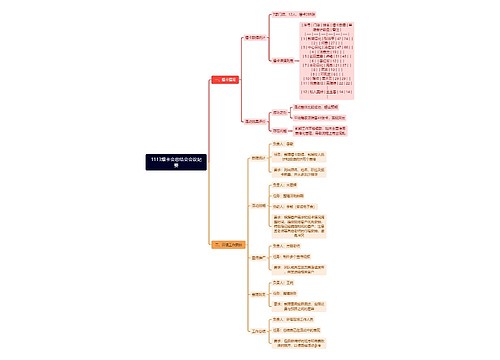
第1章 化工设计基本知识思维导图
 U882667602
U882667602树图思维导图提供《第1章 化工设计基本知识》在线思维导图免费制作,点击“编辑”按钮,可对《第1章 化工设计基本知识》进行在线思维导图编辑,本思维导图属于思维导图模板主题,文件编号是:70ec0519ed26419068a32a511862aadd

相似思维导图模版
首页
我的文件
我的团队
个人中心
